
Miniatures Collection - B3 Wassily
Marcel Breuer, 1925
Marcel Breuer replaced the massive upholstered corpus of the traditional club chair with a skeletonlike construction made out of bent steel tubing, thereby overcoming the physical weightiness of conventional seating. He exploited the elasticity of the material, complementing it with tautly stretched fabric strips of reinforced canvas for the seat and back. The B3 did not acquire the name »Wassily« until the beginning of the sixties, when the Italian furniture producer Dino Gavina purchased the manufacturing rights: Marcel Breuer had designed the armchair for the house of the painter Wassily Kandinsky, who taught at the Bauhaus from 1922 until 1933.
Miniatures Collection




Al meer dan twee decennia lang maakt het Vitra Design Museum miniatuurreplica’s van de mijlpalen in meubeldesign uit zijn collectie. De Miniatures Collection belichaamt de volledige geschiedenis van industrieel meubeldesign: van historicisme en art nouveau tot Bauhaus en nieuwe zakelijkheid, van Radical Design en postmodernisme helemaal tot aan de huidige periode. De stoelen, die precies een zesde van de grootte van de historische originelen zijn, zijn volledig op schaal en geven zelfs de kleinste constructie-, materiaal-, en kleurdetails nauwkeurig weer. De authenticiteit van de meubels gaat zo ver als de natuurlijke nerf van het hout, de reproductie van schroeven en de minutieuze handwerktechnieken. Dit maakt van de miniaturen geliefde verzamelobjecten maar ze zijn ook bij uitstek geschikt als didactisch materiaal voor universiteiten, designacademies en architecten.